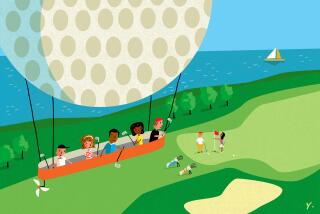A Course That Delivers Golf at Its Finest
- Share via
The first thing one must understand about Winged Foot, whose West course this week plays host to its fifth U.S. Open, is that it is a golf club. Tennis? Absent from the landscape. Swimming? A modest pool does exist, but the uninitiated might need a map to find it.
At Winged Foot, the Royal & Ancient game rules virtually unopposed.
But the attraction of this American golf institution in Mamaroneck, N.Y., lies far beyond a simple recitation of facilities, or even the obvious greatness of its two A.W. Tillinghast-designed courses. For Winged Foot is one of the truly special places in American golf, a club where, from the moment of arrival, one is drenched in a unique and timeless ambience, a sense that this is golf at its finest, in all manner of ways.
Growing up in nearby Larchmont, I had the good fortune to experience Winged Foot many times in my youth, playing there frequently, attending two U.S. Opens and even caddying on the odd Friday afternoon. Today, some two decades later, so many details remain unforgettable, from the modest stone-pillared entrance off Fenimore Road to the splendid, ivy-dotted English Tudor clubhouse, to the immense American elm overhanging the 10th green of the East course -- the death of which, several years back, represents the sole major change to the club’s time-honored landscape.
Most of golf’s hallowed places have an aesthetic all their own. At Pine Valley it is the sand barrens, at Cypress Point the rocky shoreline of the Pacific, at St. Andrews the centuries-old homeward march through the heart of the Old Grey Town. Winged Foot is, to be sure, a bit more staid than those iconic spots, yet for me one quality has always stood out: It is, quite simply, the greenest place I have seen in the world of golf.
And this, I hasten to add, is a good sort of green, not the showy, over-fertilized variety common at so many modern, out-to-impress clubs. It is the green of the countless pines, spruce and maples that tightly -- some say too tightly -- define its corridors of play; the green of the club’s famously nasty rough, and some of the purest putting surfaces ever constructed. Winged Foot, I am certain, is in elite condition more often than any cold-weather course in America, yet this spotless maintenance in no way seems ostentatious. It is, one senses, simply the way it has always been, the way the club was put here to be.
Much of this timelessness comes from the rich volume of golf history that has been written there: On the West course, four U.S. Opens, a PGA Championship, two U.S. Amateurs and a Walker Cup; on the East, two U.S. Women’s Opens and the inaugural U.S. Senior Open. Beyond this catalog of great golf moments, however, lies another important ingredient: a roster of golf professionals virtually unmatched in the annals of the American country club.
In the early years there was Mike “King” Brady, one of American golf’s first great homebred stars, and then the immensely popular Craig Wood, 1941 Masters and U.S. Open champion. But the defining days of the Winged Foot pro shop surely came from 1945 to 1978, when Claude Harmon, 1948 Masters champion and father of a brood of modern swing gurus, ruled the roost. On Harmon’s watch, Winged Foot probably had more future PGA Tour stars on staff than any club in history, a dazzling array that included Hall of Famer Jack Burke Jr., 1965 PGA winner Dave Marr, 1957 U.S. Open champion Dick Mayer and frequent tour winners Mike Souchak and Shelley Mayfield, among others. Harmon, in addition to winning the Masters, also set the course record of 61 -- on both the East and West courses.
Winged Foot’s most revered professional, however, did not work at the club but instead retired there: the legendary Silver Scot, Tommy Armour. Winner of the 1927 U.S. Open, 1930 PGA and 1931 British Open, Armour arrived as a dues-paying member in 1952, and is fondly remembered for holding court daily in the grill, scotch whiskey and cigarettes close at hand. Also widely recognized as one of the game’s finest teachers, Armour wrote several prominent instructional volumes during this period, with 1953’s “A Round of Golf with Tommy Armour” presenting a fictional game played over what sharp eyes will recognize as a thinly disguised version of the West course’s front nine.
All of which brings us back to the club’s centerpieces, the golf courses. There is an age-old debate among the membership as to which, in fact, is the better layout, and I suppose the issue really boils down to personal preference. The West, recently extended to 7,264 yards, is a monster. In 1974, during what became known as the “Massacre at Winged Foot,” Hale Irwin won with a seven-over-par 287, which remains the highest winning total of the last 43 years.
The East, on the other hand, runs a bit shorter (6,816 yards) but is considerably more varied, its elevated, steeply contoured greens being somewhat more dangerous than those of the West, though they are generally approached from more manageable distances. It makes for an interesting dichotomy, this “tougher versus fairer” aspect -- and seldom on a single property does one see both styles so effectively applied.
There is a long-circulated story -- entirely apocryphal -- that the club’s first U.S. Open (1929) was originally scheduled for the East course, being moved at the last minute because of damage from a storm. Though untrue, such a tale does remind us that if prepared in a comparable fashion, the East would certainly make for a fascinating major championship venue. Indeed, one of its great proponents, the late Dave Marr, once suggested to me that given the comparative dangers of the two layouts’ approach shots, “The West is a bogey course, but the East is a double-bogey course.”
The crux of this week’s U.S. Open challenge will still be the West’s green complexes, their slick, rolling putting surfaces flanked, seemingly on all sides, by some of the deepest bunkers in American golf. My own most vivid memory of Winged Foot, in fact, is of watching a high school teammate hit his approach at the par-three 10th into a right greenside bunker, then take eight full swings to extricate it before ultimately carding a 12. Of course, my teammate has hardly been alone in finding perdition in that particular hazard, for when asked by a curious fan if he recalled that same bunker from his youthful days at the club, Marr wryly replied: “Know it? I used to have my mail delivered there.”
Such has been the challenge of Winged Foot for some 83 years now, and despite the onslaught of unregulated equipment technology, so it figures to remain, even for the world’s elite, in the week ahead.
*
Daniel Wexler is a Southern California author and golf writer.
*
Winged Foot Opens
Results of previous U.S. Opens held at Winged Foot Golf Club:
* 1929 -- The legendary Bobby Jones earned his third Open championship the hard way, making seven twice on his final round and needing to hole a 12-foot putt on the last green to tie Al Espinosa. In a two-round playoff, he defeated Espinosa by 23 strokes.
* 1959 -- Taking the lead in the second round and holding it the rest of the way, Billy Casper held on to win by a stroke over Robert Rosburg.
* 1974 -- With the course set up for 6,961 yards, the result was “The Massacre at Winged Foot,” with Hale Irwin taking the championship at 287 -- seven over par.
* 1984 -- Greg Norman made up three shots in the final nine holes to force an 18-hole playoff, but Fuzzy Zoeller rolled to an easy victory, shooting 67 to win by eight.
More to Read
Sign up for The Wild
We’ll help you find the best places to hike, bike and run, as well as the perfect silent spots for meditation and yoga.
You may occasionally receive promotional content from the Los Angeles Times.






